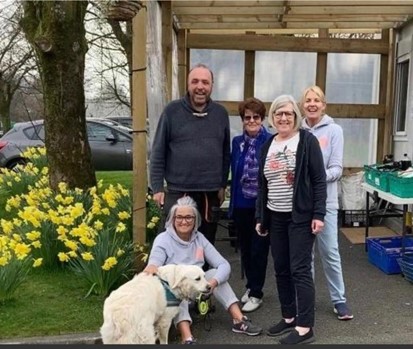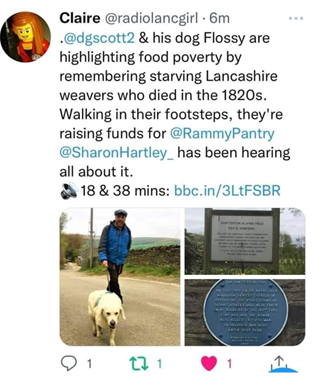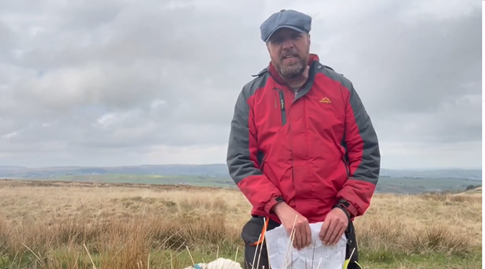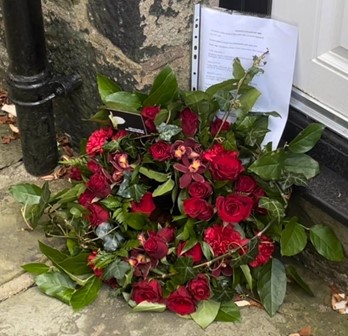Walking as Activism: The inaugural ‘Weavers Uprising Remembrance Walk’
Between 24-28th April 2022, Dr David Scott initiated and led the inaugural ‘Weavers Uprising Remembrance Walk’, a 45 mile walk following in the footsteps of starving handloom weavers in east Lancashire 196 years ago. During this uprising handloom weavers and other working class people attempted to send a symbolic message to government about their precarious living conditions through the destruction of more than 1,100 powerlooms in the local mills.
.jpg)
Whinney Hill, Near Accrington (photo taken 29th of January 2022)
Learning the Walk, and Walking to Learn
Walking can be a powerful way of engaging with the lives and experiences of others. The physical sensation of walking and how we perceive and occupy the space around us, whether it be moors, riversides, woods, or man-made buildings and artefacts – can help stimulate an interest in how and why things are as they are. Being physically present in the moment and fully utilising our natural senses can heighten our awareness. When walking in the countryside, as a matter of physical safety, one must be constantly aware of where one is going to ensuring safe passage. But our senses are stimulated in other ways too: seeing and admiring the natural beauty of the land, perhaps unchanged for decades; listening varied and diverse from oncoming vehicles or rattling hoofs of livestock to bird song to the sound of a babbling brook; and physical touch of the land beneath us and other objects we encounter. Walking is an embodied and performative physical activity but it is also an emotional experience that can lead to a greater connection with the world around us, past, present and future.
Walking is a regular and functional part of daily life for many people, but it can be undertaken as form of education and activism. Walking can result in increased intellectual stimulation and motivation or even generate a desire to learn more about a given locality. Walking can inspire further investigations and readings and this new knowledge may result in the initiation of new walks. In this sense, walking can become a form of praxis, where knowledge and actions intertwine.
One example of ‘walking as praxis’ is the ‘Weavers Uprising Remembrance Walk’ which took place for the first time between 24th – 28th April 2022. Walks, like the remembrance walk, are a form of direct activism: the activity of the walk created a story for the present by shining a spotlight on a long forgotten and lost event in the past. As the local area remains in part close to as it was when the original events took place, the remembrance walk was almost akin to a kind of time travel. For to walk in the footsteps of the long dead can alter our perceptions of the weavers uprising in east Lancashire, deepening of our understanding of their daily lived realities. At time the remembrance walk was also a ‘guided walk’ where knowledge was collectively gleaned and shared in the very place (and is the case of the remembrance walk this year on the 196th anniversary) day and sometimes the time it occurred in the past. Walks like this are about as close as we can ever come to engaging with the past and can generate a sense of emotional proximity to lives long gone.
Although there is, of course, no direct way to physically experience the lives of people long dead – our diets, clothes, culture and the welfare and educational support across our life-courses create too large a gap to simply put ourselves directly in their place - to share a physical and emotional experience of a long walk on the same soil/terrain as the weavers can still glean some unique insights. Whilst sharing their journey – albeit 196 years later – it is still possible to feel tired and recognise the toughness of walking over the west Pennine moors, for example, even when on a full belly, with food and water supplies, in decent clothes and hardy shoes (something which many of the weavers lacked).
In other words, retracing the steps of others and sharing their space can result in new ways of generating empathy, seeing at least in some partial way what the weavers saw, and forging a sense of remembrance of their suffering and struggles for survival. By empathising and understanding anew the weavers’ motivations for the uprising, we may take a step closer to recognising their inherent dignity in the face of a humanitarian disaster that was to leave tens of thousands with little or no food for months on end.
Walking as an act of remembrance can energise, create new meaning, and bring to life the past in a way that many people can directly engage with. By disrupting existing, taken for granted knowledges and assumptions and deepening- or revealing now lost knowledge of the bare life of the weavers, walking may help in the wider objective of reinterpreting what happened in April 1826 from the view of the weavers themselves. The ‘Weavers Uprising Remembrance Walk’ may become a kind of stepping-stone to collective remembrance, for by bringing people together, the walk provides an essential relational and community dimension in the present.
The Weavers Uprising Remembrance Walk though was initiated primarily as a means of making the weavers uprising visible once again in the present. But more than this, by its very title (an ‘uprising’), its focus on the indiscriminate killings at the Chatterton Massacre, and emphasis upon the context of starvation and denial of political voice, the remembrance walk also aims to challenge the dominant interpretation of the events and place the spotlight firmly on what the weavers had to go through in terms of food poverty.
The remembrance walk was planned in early 2022, and the route was slowly formed through the reading of accounts of the uprising and direct physical ‘re-walking’ along. or close to, the original route. It took approximately three months to plan, design and execute the walk. It was also important to connect the walk to the present, most notably the ‘cost of living crisis’. The local foodbank for Rossendale, The Ramsbottom Pantry, agreed to collaborate, and the full five day walk (to be undertaken by David Scott and his dog Flossy) became a sponsored walk. After a presentation by this author, The Lancashire Association of Trade Union Councils agreed to pay for the wreath that was laid at No. 12 Chatterton cottages on Day 3 of the walk. This remembrance walk was thus conceived as a way of remembering the suffering of the past, but at the same time creating a positive intervention that could shine a spotlight on the present, in terms of food poverty, as well as trying to generate social solidarity and a sense of community though a collective endeavour.

The Launch of the Remembrance Walk at Ramsbottom Pantry Foodbank
Local media interest, an important aspect of raising awareness of the uprising, was also generated with several short articles published in local newspapers (online and sometimes in print) across east Lancashire, plus also interviews with BBC Radio Lancashire which was broadcast on the morning of Day 4 of the walk and an interview with True Level Media, which was recorded on Day 3 of the walk and released at the end of May 2022. During each day of the walk, I also made a ‘video diary’ – which included more than 40 short mobile phone video clips that were made immediately available on the Weavers Uprising Bicentennial Committee @uprisingweavers Twitter feed and Facebook page. Collectively, these media interviews and recordings document and provide the opportunity for the inaugural remembrance walk to be shared with those unable to participate in a 45 mile walk in five days.

BBC Radio Lancashire Twitter Post on Interview, Day 5
Because of insurance considerations, most of the remembrance walk had to be conducted with personal invitees only, and friends from as far away as Leeds, Liverpool. Lancaster, Wigan, Warrington and Manchester attended on different days of the walks. Representatives of Ramsbottom Pantry also participated on Day 1 of the walk and attended the wreath laying ceremony. Very significantly, a segment of Day 3 of the remembrance walk – the route between Dearden Clough Mill in Edenfield and the site of Aitkens and Lords Mill in Chatterton – was co-organised and co-led with Barbara Smith, chair of the South Pennines Archaeological Society [SPAG]. More that 30 people attended thus guided part of the walk, which included numerous detailed explanations and accounts of the uprising; the reading of the Riot Act (by Barbara Smith); and the wreath laying ceremony in Chatterton. This part of the remembrance walk provided an illustration of how the wider goal of engaging with others and learning together could be accomplished.
The Weavers Uprising and the Remembrance Walk, April 2022
The following overview provides a brief account of the five days of the inaugural remembrance walk and intertwined in each day summary, is a short outline of the actual route and actions of the weavers and other protestors in 1826, including details of the mills and other sites they visited and the number of powerlooms they destroyed at each given location.
The first day of the remembrance walk started at Whinney Hill, on the outskirts of Accrington, as the weavers uprising had done 196 years ago. Shortly before 11.00am, four of us started the inaugural remembrance walk. At about the same time on the morning of 24th of April 1826, more than 1,000 people gathered there. The crowd heard speeches from the local ‘captains’, (who were the leaders of the uprising across the next four days and held together the focus and discipline of the crowd). Although some of the protestors made their way north to Clitheroe, they were met there by militia and a cannon defending their target, Horsfalls Mill, and the crowd quickly dispersed. Some of those who had journeyed to Clitheroe from Whinney Hill returned home but others continued their journey to Colne and then into West Yorkshire, where a further but more sporadic uprising took place during May 1826.
On the 24th of April 1826 though, the vast majority of those gathered at Whinney Hill headed west towards Oswaldtwistle and Blackburn. Their mission was clear – to destroy all the powerlooms in east Lancashire without unnecessary destruction of property or any violence to the person. A total of 415 powerlooms were destroyed by weavers on the first day of the uprising. The remembrance walk followed the route of the weavers as they marched down into Accrington town centre and to Higher Grange Lane Factory Mill and Woodnook Mill and destroyed 64 powerlooms in total. The protestors then marched to a mill at Fern Gore, where a further 20 powerlooms were destroyed. After this, the protestors back in 1826 made their way into Oswaldtwistle and to White Ash Mill to destroy 94 more powerlooms. At this point, the inaugural remembrance walk took a more scenic route, making its way round the outskirts of Oswaldtwistle and then down through the nature reserve on the edge of Stanhill. The protestors 196 years ago had been more direct and had headed to Jubilee Street in Blackburn. At around 3.30pm that day, the Riot Act was read. Two mills in Blackburn were attacked and more than 230 powerlooms were destroyed. A massacre was narrowly averted due to the narrow streets around Jubilee Mill, although two protestors, James Howarth and Edward Houghton, were seriously wounded by soldiers.

Mobile Phone Video Diary on Haslingden Moor, Day 2 of Remembrance Walk,
25th of April 2022
Day two began on the outskirts of Darwin. On this day, back in 1826, 158 powerlooms were destroyed in total. At 10.00am on morning on the 25th of April 1826 around 2,000 protestors gathered in Earcroft and marched to Bowling Green Mill where they destroyed 22 powerlooms with 15 minutes. A further 16 were destroyed there a few minutes later. The remembrance walk followed the route of around 300 protestors in 1826 who had made their way through Lower Darwin and over to Hoddleston, a small, picturesque village where mill owner John Garston had lived. The weavers had gone there to beg for food. When Garston refused to give them any bread, they destroyed 14 power looms on his property.
After the leaving Garston’s property, an estimated 400 weavers made ther way to Pickup Bank and then onto the rugged West Pennine Moors. The moors stretch as far as the eye can see towards Haslingden and Ramsbottom. It is not easy to walk on these moors, even with good walking boots. It would have been quite difficult terrain for the weavers, especially for those without shoes, or wearing cumbersome clogs on their feet (or indeed any women with long skirts). Many would not have been walking on the pathway and would have to struggle over the long grass, all on empty belles and for some only rags for clothes. The weavers back in 1826 made it across the moor and down by Mulsbury Valley and into Helmshore to what was then Turners Mill (Middle Mill) and is today Helmshore Textile Museum, where they were met by a number of bystanders, including the six year old daughter of Mary Hindle. The Riot Act was read (before the soldiers arrived) but did not prevent the destruction of 106 powerlooms. When the soldiers did arrive, 23 people at the mill, including the unfortunate Mary Hindle who had done nothing more than offer encouragement to the powerloom breakers, were arrested and taken to the New Inn, Haslingden. The crowd followed. At the New Inn, the local magistrate Reverend Gray, under intense pressure from the crowd, and with the ever increasing likelihood of soldiers opening fire on an unarmed crowd, decided all the prisoners should be released.
Day three of the remembrance walk was on the day the of the Chatterton Massacre. Early on the morning of the 26th of April 1826, more than 1,000 weavers made their way to David Whiteheads mill, where they destroyed 96 powerlooms in less than 30 minutes. Next was Longholme Mill, situated by the River Irwell on the outskirts of Rawtenstall where 20 powerlooms were destroyed. After a further 3 powerlooms had been destroyed at the adjacent Hoyle and Ashworth Mill, up to 4,000 protestors set off up the valley towards Edenfield.

The Remembrance Wreath, Day 3 of the Weavers Uprising Remembrance Walk
The inaugural remembrance walk started early morning in Rawtenstall and like the weavers went across the back roads to cover the 3 mile, 800ft high walk over to Dearden Clough Mill, Edenfield and then down into Chatterton itself. At around 10.30 am, 30 people gathered in Edenfield for the walk into Chatterton. The Riot Act was read by Barbara Smith, portraying the Magistrate William Grant. Following a brief overview of the massacre and naming of those who died in the Massacre by David Scott, a wreath was lad for all those who died. This remembered not just those at Chatterton, but also the people who had died in related protests in Bradford, West Yorkshire and the struggles in Oldham, Rochdale and Middleton in the weeks that followed. Indeed, only a week after the Chatterton Massacre, Henry Fearnley who was a 13 year old boy and Jonas Bairstow who was 18, were shot dead after breaking into Horsfall's mill in Bradford by the Yorkshire Hussars. Also noted was the death of Thomas Ashworth who died after being given the death sentence and the literally thousands of other people who died premature deaths in east Lancashire and surrounding areas in 1826-7 due to the consequences of starvation and related diseases.
Following the Chatterton Massacre in 1826 the crowd split in two and on day three of the remembrance walk the route followed the path of those who went to Higher Summer Mill (where 38 powerlooms destroyed) and then the pathway alongside the River Irwell to Woodhill Factory, in Elton, Bury. Here, for the first time, the weavers 196 years ago did not complete their mission. Only 49 of the 200 powerlooms in the mill were destroyed. During their work the protestors were disrupted by soldiers and quickly dispersed, with memories still fresh from the killings earlier in the day.
Day four of the remembrance walk started in Tockholes and made a 9 mile journey first down to Abbey Village and then via the nature trail down to Brinscall. Four people undertook the inaugural remembrance walk on this day. Walking along the path of the old railway line, the remembrance walk continued to White Coppice and then on to Healy Nap before making its way to Botany Bay on the outskirts of Chorley. Although this day of the uprising, the 27th of April, 1826, started with just a couple of hundred people, the protestors were joined by a large crowd of bystander and by the time they reached their only target for the day, the Water Street Factory in Chorley, where 80 powerlooms were destroyed, the crowd had swelled considerably in number.
The final (extra) day of the remembrance walk followed the roue of the vast majority of those who were dispersed following the Chatterton Massacre on the 26th of April 1826. That afternoon, the protestors walked back up into Rossendale and then on towards Bacup. At least 500 of the survivors of the Chatterton Massacre made their way to Holt Mill at Waterfoot, where 20 powerlooms were destroyed. As the crowd back in 1826 gathered still greater strength, 50 further powerlooms were destroyed at Howarths Mill in Waterbarn. The next destination was Irwell Mill, where 28 powerlooms were destroyed before the protests in this part of east Lancashire ended at Old Clough Factory, near Bacup, where the last 52 powerlooms in Rossendale were destroyed. At this same destination the inaugural weavers uprising remembrance walk also came to a close.
